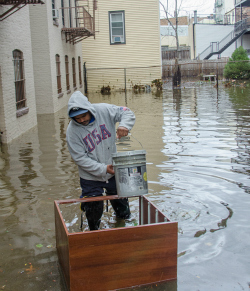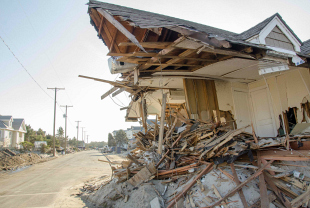The federal government is poised to expand flood zones and push for increases in building elevations along the New Jersey coast in the wake of flooding from Hurricane Sandy.
The Federal Emergency Management Agency was planning to revise flood-elevation rules in coastal zones sometime next year, but due to the extensive damage caused by the storm it will issue stricter advisory recommendations as early as next week.
The rules, expected to result in construction at much higher elevations along the New Jersey shore, will be pushed earlier than expected to make sure rebuilding from Sandy will follow stricter codes. The concern was that people would rebuild to today’s requirements and that new construction already would be obsolete sometime next year.

“In all likelihood, they will change the building heights. Next week we’ll have a better idea of what’s actually going to happen when these advisories come out,” Neil Byrne, the construction official and certified flood plain manager for Sea Isle City, told The Press of Atlantic City.
FEMA will issue “Advisory Base Flood Elevations,” dubbed Advisory BFEs, for New Jersey’s coastal counties next week and follow that the week of Dec. 17 with Advisory BFEs for New York coastal areas. The Advisory BFEs will be estimates of areas that have a 1 percent chance of being flooded each year, the so-called 100-year storm, and will be expanded from current mapping.
Byrne was one of the flood managers who participated in a recent online seminar with FEMA that has created a buzz along the shore that the agency would extend to other areas the strict rules that apply to V-zones along the shore. The V-zones are high-velocity wave zones along the beach that have the strictest elevation and other building requirements.
Shore towns typically have a V-zone along the beach and different A-zones behind it. Sometimes the highest ground, with no real flood concerns, can be a different zone, often called an X-zone.
Each town has its own zones and heights that affect FEMA ratings and flood insurance costs. In Sea Isle City, which has one of the better FEMA ratings along the shore, construction must be at 14 feet above base flood elevation in the strictest V-zone.

Besides the V-14 zone, Sea Isle also has a V-12 zone calling for 12-foot heights, along with A-10 and A-11 zones. Sea Isle requires an additional foot to all zones for what is known as “freeboard” underneath a structure. That means, for example, that floor joists on the first floor of structures in the V-14 really must be 15 feet above base flood elevation. Adding freeboard can improve FEMA ratings. Some towns add two feet of freeboard in each zone and get better FEMA ratings.
Long Beach Township Mayor Joseph Mancini said there is a lot of speculation about what the new regulations could include.
On Friday afternoon, the township held its regular Board of Commissioners meeting, which usually lasts for about 20 minutes during the winter months but went on for about an hour with discussion of the flood maps.
“Everyone is concerned about what’s coming out. I’ve told everyone, `Relax. We’ll see what it is, and we’re going to have to conform to whatever it is,”‘ Mancini said.
When it comes to discussion about extending the V-zone back toward the street, that would address issues of wind and water impact in the township’s Village Harbor section that Mancini said took a beating when 4-foot waves were hitting homes.
Bryne said many properties in town suffered substantial damage from Sandy and should be rebuilt to the new standards, but he noted it still isn’t clear what they will be. It’s also unclear if they will be stricter than what would have been required next year if Sandy had not hit.
The FEMA spokesman for New Jersey did not return phone calls Thursday and Friday. A spokesman for FEMA in Washington also did not supply requested information on Advisory BFEs.
“It all depends on how high they raise the BFEs,” Byrne said. “They could come up with a zone called a Coastal A, which would be an area of limited wave action, waves of less than 3 feet, behind the V-zones, where building is to the same standards as the V-zone.”
North Wildwood Mayor William Henfey was concerned. He said new construction could dwarf existing homes built at ground level.
“The shore towns are already built up,” argued Henfey. “There’s got to be a better way. Let’s just not go overboard.”
Cape May Point Deputy Mayor Anita van Heeswyk said new mapping by FEMA in 1995 put her Central Avenue home in a flood zone even though water has never been on the property. Van Heeswyk participated in the online seminar and said one thing she got from it is FEMA is pushing for more freeboard under homes and the new maps will come with higher flood insurance premiums.
Paperwork van Heeswyk received from FEMA said the Advisory BFEs will reflect higher elevations than on current flood insurance-rate maps. It said coastal flood zones may extend further inland. FEMA also predicted higher initial costs but lower long-term costs due to less flood damage.
Whatever height requirements emerge, Byrne said they will apply only to new construction or restoration work under the damage rules.
The FEMA recommendations are also not law. Towns still must put any new height or building requirements into local ordinances. Byrne said there would be public hearings before anything is enacted.
Failure to follow FEMA guidelines, however, can affect the agency’s ratings for the town along with the price and availability of federal flood insurance. Following what FEMA wants can lower premiums and possibly even result in more storm-reconstruction money. Homeowners in towns that conform to FEMA rules can get as much as $30,000 for flood-proofing, elevation, relocation or demolition of a house in a high-risk area.
Older towns with ground-level construction could face the most aesthetic problems. In Cape May, a town full of 19th-century homes, most are built at ground level.
“The problem is you’ll be able to build less and everything will be up on piling,” said Construction Official Bill Callahan, who also serves as flood plain manager.
Prior to Sandy, FEMA had been expected to unveil new flood maps next August. FEMA is now expected to issue Advisory BFEs for 10 counties in New Jersey and eight in New York.
Coastal homeowners already were facing higher flood-insurance costs before Sandy hit. A federal law approved in July re-authorized the National Flood Insurance Program for five years but eliminated a lot of discounts and subsidies, including those for secondary homes, many businesses and properties that suffer repeated flood damage.
Topics Flood New Jersey Construction FEMA
Was this article valuable?
Here are more articles you may enjoy.


 MAPFRE Accuses AAA of Violating Long-Time Exclusive Marketing Agreement
MAPFRE Accuses AAA of Violating Long-Time Exclusive Marketing Agreement  Adjusters Launch ‘CarFax for Insurance Claims’ to Vet Carriers’ Damage Estimates
Adjusters Launch ‘CarFax for Insurance Claims’ to Vet Carriers’ Damage Estimates  Expense Ratio Analysis: AI, Remote Work Drive Better P/C Insurer Results
Expense Ratio Analysis: AI, Remote Work Drive Better P/C Insurer Results  Billionaire NFL Owner Suing Over Billboards Near His LA Stadium
Billionaire NFL Owner Suing Over Billboards Near His LA Stadium 

